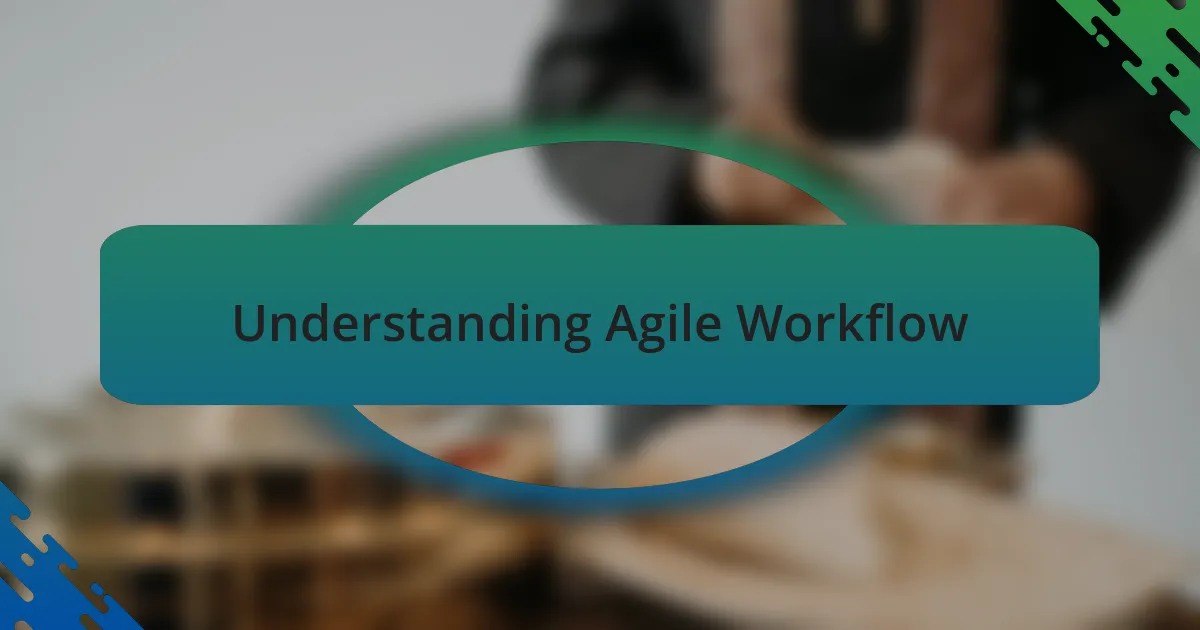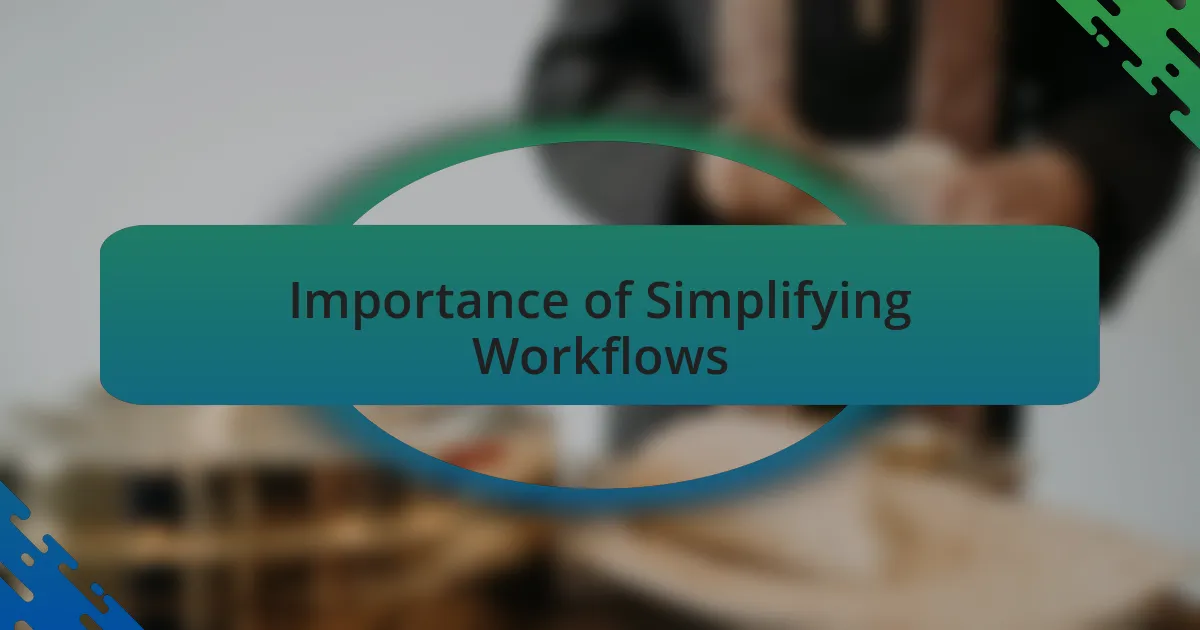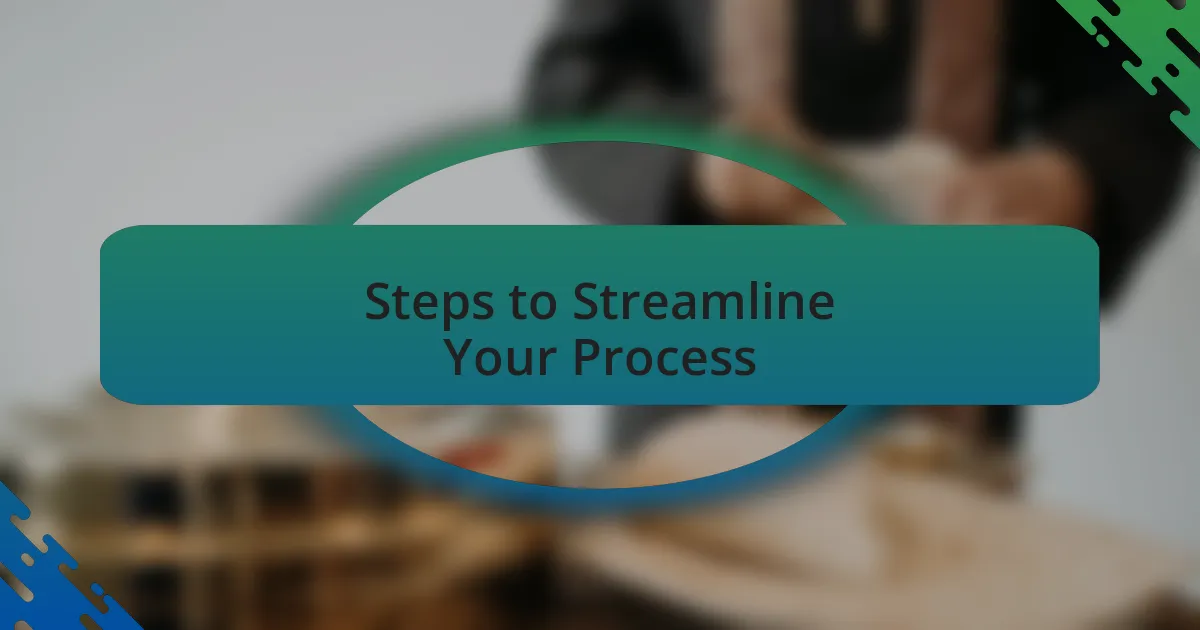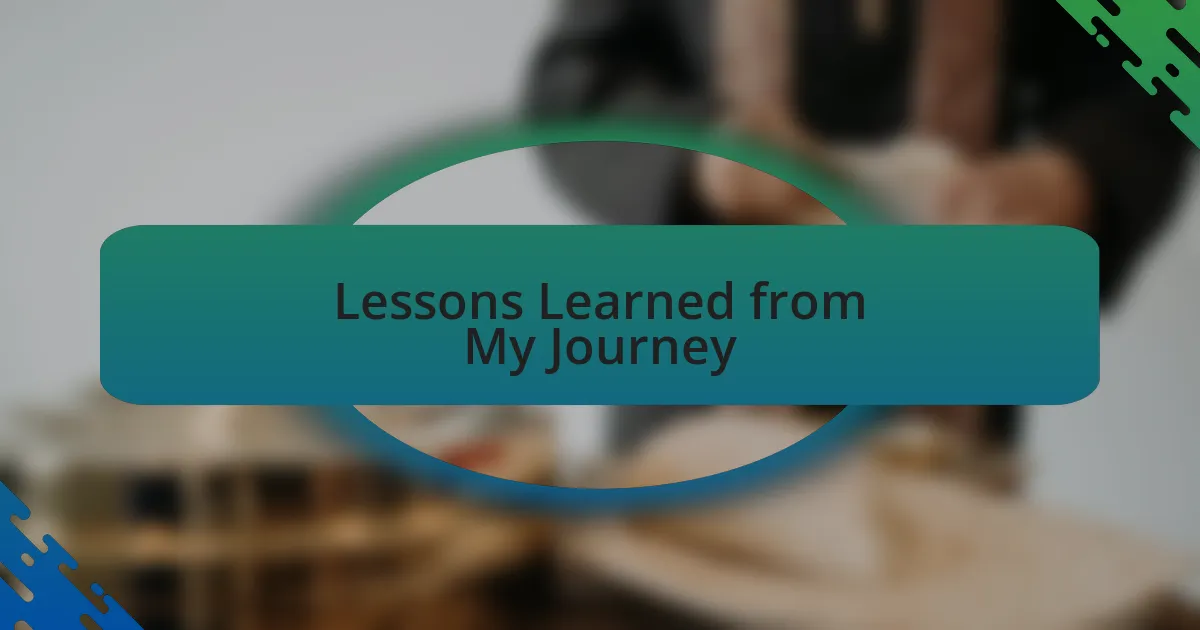Key takeaways:
- Agile workflow emphasizes flexibility and collaboration, allowing teams to adapt quickly to changes and focus on delivering value incrementally through sprints.
- Simplifying workflows enhances communication and innovation, reducing bureaucracy that stifles creativity and productivity.
- Common challenges in Agile include maintaining goal alignment, managing stakeholder expectations, and overcoming resistance to change among team members.
- Key strategies for streamlining processes involve daily check-ins, visualizing work with Kanban boards, and prioritizing retrospectives for meaningful feedback.

Understanding Agile Workflow
Agile workflow is fundamentally about flexibility and collaboration. I remember when I first stumbled upon Agile while working on a project with a tight deadline. The traditional waterfall approach felt stifling, and I was looking for a way to get feedback quickly and implement changes on the fly. Agile transformed my perspective, allowing me to embrace changes rather than fear them.
In an Agile environment, work is broken down into smaller, manageable increments called sprints. During my initial sprint planning sessions, I was surprised by how much clearer our goals became. It was no longer about delivering everything at once; instead, we focused on what added the most value to the end-user. Seeing my team rally around these goals was a moment of pure joy and realization.
It’s intriguing to consider how Agile encourages iterations. Every time I completed a sprint, I felt a mix of accomplishment and curiosity about what to improve next. Have you ever felt that rush when you see your hard work come to life in just a few weeks? This continuous cycle of review and improvement is what makes Agile particularly powerful, giving teams the opportunity to innovate and adapt more dynamically.

Importance of Simplifying Workflows
Simplifying workflows is crucial because it directly impacts a team’s efficiency and morale. I recall a point in my career when our team was buried under complex processes and convoluted tools. It wasn’t just frustrating; it crushed our creativity. When we took the time to strip away unnecessary steps, I immediately noticed how our communication improved, and we started focusing on producing tangible results rather than getting lost in bureaucracy.
When you simplify workflows, you create a space for innovation to flourish. I remember introducing a weekly check-in that cut down countless emails and meetings. Suddenly, instead of feeling overwhelmed, I felt empowered, and my teammates mirrored that sentiment. This streamlined approach fostered an atmosphere where ideas could flow freely, making collaboration not just easier but genuinely enjoyable.
Moreover, a simplified workflow can lead to better decision-making. I often reflect on how our team turned a critical project around by adopting a straightforward feedback loop. It not only sped up the review process but also encouraged everyone to share their insights without hesitation. Have you experienced moments when clarity leads to better outcomes? I certainly have, and it drives home the point that simplicity can transform chaos into productive momentum.

Common Challenges in Agile Methodology
One of the most common challenges I’ve faced in Agile methodology is the tendency for teams to lose sight of their goals. I remember a sprint where we became so focused on delivering tasks that we forgot to assess whether we were truly meeting our client’s needs. It left me wondering, how often do we get caught up in the process rather than the purpose? When every team member is preoccupied with completing individual tasks, the cohesion and direction of the project can drift.
Another significant hurdle I encountered is the difficulty in managing stakeholder expectations. In one project, we experienced confusion when clients had different interpretations of what “done” meant. I found myself frequently clarifying points and conducting extra meetings, which drained our energy and slowed progress. It begs the question: are we truly communicating effectively? Ultimately, setting clear definitions and maintaining open lines of communication became critical steps I took to navigate this challenge.
Lastly, the impact of team dynamics cannot be understated. I experienced this firsthand when a few members were resistant to change, clinging to their traditional ways of working. It wasn’t just a bump in the road; it felt like hitting a wall. I often wondered how we could balance the established methods with the Agile principles we were trying to adopt. Fostering a culture of openness and continuous learning helped break down those barriers. Have you noticed how a supportive environment can transform resistance into collaboration? I certainly have, and it’s a lesson that continues to shape my approach.

Steps to Streamline Your Process
One of the first steps I took to streamline my Agile workflow was to implement a daily check-in. This practice allowed my team to quickly share their progress and address any roadblocks. It was surprising to see how a simple 15-minute stand-up can create a sense of accountability and transparency, making everyone feel more aligned and focused on our common goals.
Another effective strategy was to visualize our work using a Kanban board. I vividly remember the moment we switched from a cluttered list of tasks to a visual flow—suddenly, everyone could see the state of our projects. It not only fostered a sense of ownership but also ignited conversations around priorities. How often do we underestimate the power of a visual cue in maintaining momentum?
Lastly, I learned to prioritize retrospectives not as formalities but as opportunities for genuine reflection and improvement. In one meeting, I encouraged everyone to share not just what went right, but also what made them feel frustrated. That candid atmosphere led to actionable insights that we could immediately implement. It makes me wonder—how many teams are missing out on growth simply because they skip this critical step?

Tools for Agile Workflow Simplification
When it comes to simplifying an Agile workflow, selecting the right tools can make a world of difference. I experienced this firsthand when we adopted Jira for tracking our sprints. Initially, I was overwhelmed by its features, but soon I realized how effective it was for prioritizing tasks and monitoring progress. Have you ever found a tool that initially seemed complicated but turned out to be transformative?
In addition to Jira, integrating Slack into our communication was a game-changer. I remember the chaos of endless email threads and how they muddled our discussions. Switching to channels for specific projects not only streamlined our conversations but also fostered a sense of camaraderie among team members. It’s fascinating how the right communication tool can turn isolated work into collaborative efforts.
Finally, I discovered the benefits of using time-tracking tools like Toggl. At first, I thought accountability was enough, but seeing where we spent our effort opened my eyes to inefficiencies I hadn’t noticed before. How often do we think we’re optimizing our time, only to realize we need a clearer picture to truly understand our workflow? These insights can be pivotal in ensuring that our Agile processes remain efficient and impactful.

My Personal Experience in Agile
Adopting Agile transformed my approach to project management, but it wasn’t without its hurdles. In my early days, sprint planning felt like a daunting puzzle. I remember sitting with my team, feeling the pressure as we tried to dissect our workload into manageable chunks. Questioning whether we were truly aligned, I learned that transparency in our goals made all the difference.
As I navigated through Agile practices, I found daily stand-ups to be both empowering and challenging. Initially, I was skeptical about their value, fearing they would derail our progress. Yet, I soon discovered that these brief check-ins were vital for fostering accountability and cohesion within the team. It’s amazing how just a few minutes can realign our focus and energize us for the day ahead. Have you ever noticed a shift in team dynamics just from a quick chat?
Reflecting on my journey, I recognize that feedback loops are essential to any Agile process. I recall a project where we gathered input after each iteration. The candid discussions that followed revealed insights we never would have identified otherwise. It was a humbling experience, illustrating how we often overlook valuable perspectives when we don’t prioritize open communication. How frequently do we miss opportunities for growth simply because we shy away from honest feedback?

Lessons Learned from My Journey
One lesson that stands out from my Agile journey is the importance of flexibility. Early on, we clung to our original plans, believing they were set in stone. I vividly remember a project where an unexpected requirement change threw us off course. Instead of panicking, we embraced the shift, and it became a turning point. This experience taught me that adaptability can turn challenges into opportunities for innovation. Have you ever had to pivot mid-project, realizing it led to even greater outcomes?
Collaboration is another cornerstone I learned to value deeply. I used to underestimate the power of brainstorming sessions, often thinking they were just time fillers. However, during one particular session, we stumbled upon a unique solution that completely redefined our project. The energy in that room was palpable, and it reinforced my belief that diverse perspectives can lead to extraordinary results. How often do we truly harness the collective creativity of our teams?
Lastly, I realized that self-reflection is just as crucial as team accountability. After completing each sprint, I took the time to contemplate my contributions and areas for improvement. One day, I noted that my communication was lacking and could sometimes cause misunderstandings. This prompted me to seek feedback actively, which not only enhanced my performance but also strengthened trust within our team. Isn’t it fascinating how looking inward can echo positively throughout the entire group?